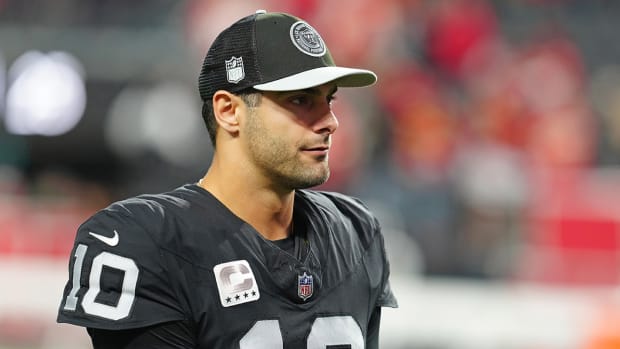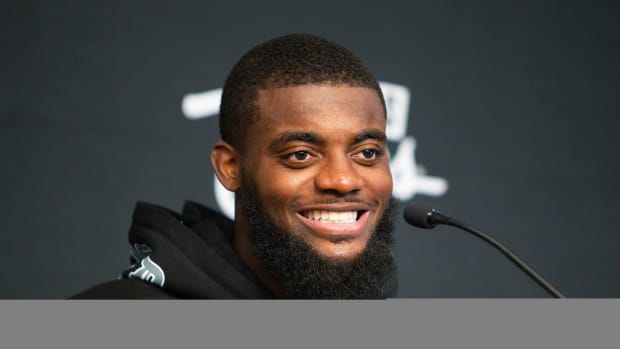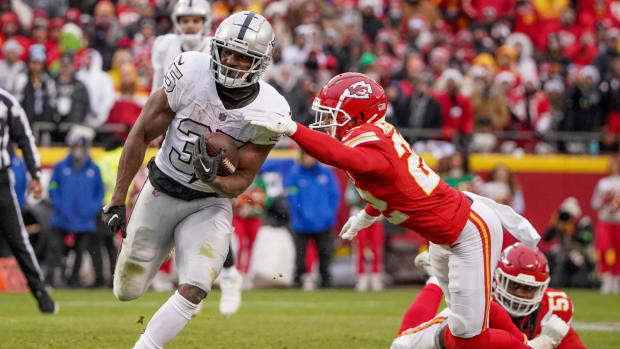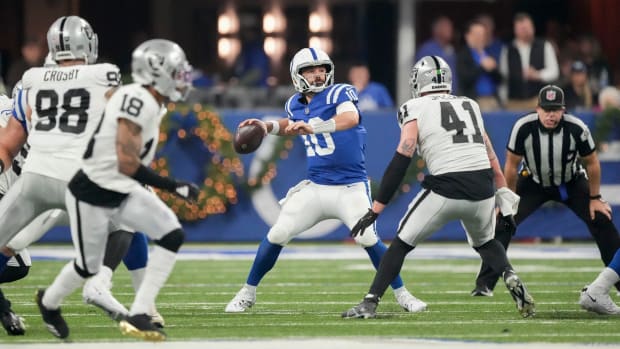Raiders All-Time Top Five: Head Coaches
1. John Madden, 1969-1978
Madden was so into his job of coaching the Raiders that it eventually forced him into early retirement in 1979 because of a deteriorating ulcer condition and occupational burnout after 10 years as a head coach of the Silver and Black, seven seasons as an assistant, and two years as head coach at Hancock College in California. Madden grew up in Daly City, Calif., as best friends with John Robinson, who later was his assistant with the Raiders before becoming a legendary head coach at USC. Madden played at Oregon, along with Robinson, before sustaining a knee injury, and returned to finish his college career as a two-way tackle at Cal Poly San Luis Obispo, where he earned all-conference honors and also played catcher on the baseball team. He was drafted in the 21st round (No. 244 overall) of the 1958 National Football League Draft by the Philadelphia Eagles, but another knee injury sustained in training camp ended his playing career. “I got hurt in my rookie year with the Philadelphia Eagles, a knee injury, and I couldn't play. While I was rehabbing (legendary quarterback) Norm Van Brocklin would be watching films and would explain what was happening. I ended up with a degree in teaching, and my love for football meshed with teaching.” Madden began his coaching career as an assistant at Allan Hancock Junior College in California in 1960 and two years later was promoted to head coach, before Coach Don Coryell of San Diego State hired him as defensive coordinator in 1964. After three years with the Aztecs, Al Davis brought him to Oakland as linebackers coach, and in 1969 he became head coach of the Raiders at the age of 32. All Madden did was compile a 103-32-7 record in 10 seasons, becoming the youngest coach in NFL history to reach 100 victories, was named Pro Football Weekly’s American Football League Coach of the Year in 1969, and was elected to the Pro Football Hall of Fame in 2006. However, Madden’s crowning moment came after the Raiders went 13-1 in the 1976 season, defeated the New England Patriots, 24-21, in the first round of the playoffs, beat the two-time defending Super Bowl champion Pittsburgh Steelers, 24-7, in the AFC Championship Game and dominated the Minnesota Vikings, 32-14, in Super Bowl XI. Madden always was cautious with what he said before a big game, publicly and privately, but not this time. “Unless our team bus turns over going up the canyon to the Rose Bowl on Sunday, this one won’t even be close,” he told confidants early in the week. After the game, Madden said: “Super Bowl XI was ours and 10 years from now or 20 years from now, Super Bowl XI will still be ours. I’ll never take off the Super Bowl ring. It’s something I will always cherish.” Unfortunately, the Raiders never reached the Super Bowl again under Madden, losing the 1977 AFC Championship Game to the Denver Broncos when an obvious fumble by running back Rob Lytle was recovered by defensive tackle Mike McCoy of the Raiders, who was running for an apparent touchdown when the play was called back because head linesman, Ed Marion didn’t see the fumble, and the Broncos won, 21-17. “How can your guy have the ball and come running out of there and not have possession?” Madden asked, “There’s only one damned ball and we ended up with it.” The Raiders went 9-7 the next season, failed to make the playoffs, and Madden was done. Of course, he became a television star as a football analyst and in Lite Beer commercials after that.
2. Tom Flores, 1979-1987
Flores, who was the first Raiders quarterback in the inaugural season of the American Football League in 1960 out of University of the Pacific, had a tough act to follow in 1979 when Al Davis named him to replace John Madden as coach of the Silver and Black, but he was more than up to the challenge. In fact, Flores became the only head coach to lead the Raiders to two victories in the Super Bowl and will be inducted into the Pro Football Hall of Fame in Canton, Ohio, in August. Flores, who grew up in Sanger, Calif., near Fresno in California’s San Joaquin Valley, played quarterback at College of the Pacific in Stockton but was not drafted out of college, was cut by the Calgary Stampeders of the Canadian Football League and wound up playing for the Bakersfield Spoilers of the Pacific Coast Professional Football League in 1958. Then he tried out for the Raiders as the American Football League was formed in 1960 and became the first Hispanic quarterback to start in professional football. Flores missed the 1962 season because of a bout with tuberculosis. “I was in isolation for 10 days,” Flores recalled. “Doctors didn’t know what I had. Finally, they discovered it was a form of tuberculosis and that I wasn’t infectious. We had no insurance in those days and twins who were a year old. But I wasn’t worried about surviving.” When Al Davis came to Oakland as a coach and general manager in 1963, Flores and Cotton Davidson shared the quarterback spot and led the Raiders to a 10-4 record after seasons of 2-12 and 1-13. However, even though he was an AFL All-star in 1966, the Raiders traded him the next year to the Buffalo Bills with along wide receiver Art Powell for quarterback Daryle Lamonica, who led the Raiders to a 13-1 record and Super Bowl II, where they lost to the Green Bay Packers, 33-14. Flores was a reserve quarterback for the Kansas City Chiefs in 1969, when he was credited with helping show Coach Hank Stram how to beat the Raiders, 17-7, in the last AFL Championship Game. Davis brought Flores back to Oakland in 1972 as wide receivers coach and he held that position until replacing Madden as head coach in 1979. Flores led the Raiders to an 83-53 record in nine seasons, and to an 8-3 record in the playoffs, including a 27-10 victory over the Philadelphia Eagles in Super Bowl XV and a 38-9 rout of the Washington Redskins in Super Bowl XVIII. Flores became the first minority coach to win the Super Bowl and the Raiders became the first wild card team to win the game with their victory over the Eagles. His 83 coaching victories are second only to Madden’s 103 in Raiders history, and his eight wins in the playoffs are second to Madden’s nine. Flores left the Raiders after the 1987 season and became coach of the Seattle Seahawks in 1992, compiling a 14-34 record in three seasons. In addition to the Pro Football HOF, he has been elected to the University of Pacific Hall of Fame, the Fresno County Athletic Hall of Fame, the California Sports Hall of Fame, the California Community College Hall of Fame, and the Bay Area Sports Hall of Fame. Flores was a color commentator on Raiders radio broadcasts from 1997 until 2018.
3. Al Davis, 1963-1965
Al Davis came to Oakland as a coach and general manager in 1963 and turned a floundering franchise that was rumored to be moving almost every other week into one of the great franchises in professional sports. The Raiders were 2-12 and 1-13 in the two seasons before he took over the team and Davis led them to a 10-4 victory in 1963, including 34-33 and 41-27 victories over the San Diego Chargers, the AFL champions that season who many people believed could have beaten the NFL champion Chicago Bears. Davis, who changed the Raiders’ colors from black and gold to the now famous Silver and Black, was selected AFL Coach of the Year that season, later became owner of the team and led them to victories in Super Bowls XI, XV and XVIII, and was elected to the Pro Football Hall of Fame in 1992. He played football at Erasmus Hall High School in Brooklyn, N.Y., graduated from Syracuse in 1970 and started his coaching career as offensive line coach at Adelphia College that year. Davis also coached the United State Army team at Fort Belvoir, Va., and was a scout for the Baltimore Colts before becoming defensive line coach at The Citadel in 1955-56 and held the same position at USC from 1957-59. He hoped to eventually become head coach of the Trojans, but that job went to John McKay, who became a USC legend, and he did not keep Davis on his staff. Davis got into pro football as wide receivers coach for the Los Angeles/San Diego Chargers under legendary Coach Sid Gillman from 1960-62, before getting his chance to run the show with the Raiders in 1963, and the rest is pro football history. “We needed someone who wanted to win so badly, he would do anything,” Raiders primary owner Wayne Valley, a successful businessman, said. “Everywhere I went, people told me what a son of a bitch Al Davis was, so I figured he must be doing something right. I knew I would eventually have to fight him for control of the team, but I figured I could handle a football coach.” Valley guessed wrong. Davis compiled a 23-16-3 record in three seasons as coach of the Silver and Black before leaving to become Commissioner of the American Football League and playing a huge role in forcing the merger with the National Football League. During the AFL-NFL war, the New York Giants of the NFL made a big mistake by breaking an unwritten agreement by signing kicker Pete Gogolak of the Buffalo Bills of the AFL. “Al Davis taking over as commissioner was the strongest thing the AFL ever did,” respected sportswriter Jerry Magee of the San Diego Union-Tribune wrote. “He thought the AFL–NFL merger was a detriment to the AFL.” The New York Jets had already signed Joe Namath out of Alabama, and Davis spearheaded a plan in which the AFL signed several NFL stars, such as quarterback John Brodie of the San Francisco 49ers, tight end Mike Ditka of the Chicago Bears and quarterback Roman Gabriel of the Los Angeles Chargers, who went to the Raiders. Some NFL owners were so concerned that they went to several AFL owners, including Lamar Hunt of the Kansas City Chiefs, behind Davis’ back and reached a merger agreement. Pete Rozelle remained as NFL Commissioner and the AFL signings were negated. Davis resigned as AFL Commissioner on July 25, 1966, and AFL owners wanted Davis to continue serving as AFL President, probably because they didn’t want to compete against him. However, Davis returned to the Raiders, where John Rauch had become the head coach, and Davis became part-owner along with Valley and Ed McGah, before eventually taking over the Silver and Black, and leading them to greatness. Davis was still running the Raiders when he passed away on Oct. 8, 2011, at the age of 82.
4. John Rauch, 1966-1968
Rauch took on what could have been the difficult task of replacing Al Davis as head coach of the Raiders in 1966 when Davis became Commissioner of the American Football League. However, Rauch handled it well, guiding the Raiders to an 8-5-1 record in 1966, but finished second in the AFL’s Western Division and failed to make the postseason. However, Rauch coached the Raiders when they became a pro football powerhouse in 1967. After Davis returned to Oakland as Managing General Partner and acquired quarterback Daryle Lamonica, “The Mad Bomber,” from the Buffalo Bills, Rauch’s Raiders went 13-1, winning their last 10 games of the regular season, before routing the Houston Oilers, 40-7, in the AFC Championship Game. The Green Bay Packers downed the Raiders, 33-14, in Super Bowl II when the Raiders were handicapped by the loss to dual-threat running back Clem Daniels because of a knee injury late in the season, and Rauch was still named AFL Coach of the Year. The Raiders came right back with a 12-2 record under Rauch the following year, this time winning eight straight games at the end of the regular season and beating the archrival Kansas City Chiefs, 41-6, in the first game of the playoffs, before losing to the New York Jets, 27-23, in the last AFL Championship Game. Quarterback Joe Namath and the Jets went on to upset the Baltimore Colts, 16-7, in Super Bowl II, becoming the first AFL team to win the game. However, Rauch was finished with the Raiders. Reportedly tired of Davis’ interference with the day-to-day coaching operation of the team, Rauch resigned on Jan. 16, 1969, and became head coach of the Buffalo Bills. The Bills drafted future Hall of Famer O.J. Simpson, the Heisman Trophy-winning running back from USC that season, but could manage only a 4-10 record that season, before following that up with a 3-10-1 mark the following season. Rauch was preparing to coach the Bills for a third season when he got into a heated argument with owner Ralph Wilson and abruptly resigned on July 20, 1971, ending his NFL head coaching career with a 37-18-1 record, plus a 2-2 mark in the postseason. Rauch, who had been an assistant coach since 1952 with the University of Florida, Tulane, Georgia, and Army before coming to the Raiders as an assistant to Davis in 1963, later became an assistant with the Philadelphia Eagles, the Atlanta Falcons, and the Tampa Bay Buccaneers. He became a head coach again with the Toronto Argonauts of the Canadian Football League, leading them to records of 7-5-2, losing in the first round of the playoffs, and was 3-4 before being fired in 1974. Rauch finished his career as scouting director and offensive backfield coach of the Tampa Bay Bandits of the United States Football League in 1983-85. Before he got into coaching, Rauch was an All-American quarterback at Georgia, where he started as a true freshman and led the Bulldogs to a 36-8-1 record and four straight bowl games. He was drafted with the second overall pick of the 1949 NFL Draft by the New York Bulldogs but played only one season with them before playing the next two years with the New York Giants and the Eagles. In 1952, rather than accept a trade to the Pittsburgh Steelers to become a player/coach, he took his first coaching job at Florida. Rauch passed away on June 10, 2008, at the age of 80, apparently of a heart ailment.
5. Art Shell, 1989-1994, 1996
Shell, who was an All-Pro and Pro Football Hall of Fame tackle in his playing career with the Raiders from 1968-82, made a bit of history when he became the first African-American head coach in pro football in 68 years before the 1989 season. Shell recalls sitting in bed one night when Raiders owner Al Davis called him on the telephone. “I’m thinking about making a switch,” Davis told Shell. “I’m thinking about making you head coach of the Raiders (replacing Mike Shanahan). You understand the Raider way. You're a leader. You're smart. You work hard. Everyone respects you, so you're the perfect choice. Think about it and get some sleep.” Of course, Shell could not go back to sleep. This was a man who had once asked his friend and Raiders Coach Tom Flores: “How do I become a coach in this league?” In 1989, Shell became the second African-American head coach in NFL history, and the first since another Hall of Famer, Fritz Pollard was player-coach for the Akron Pros in 1921. “It is an historic event and I understand the significance of it,” Shell said at the time. “I’m proud of it, but I’m also a Raider. I don’t believe the color of my skin entered into this decision. I was chosen because Al Davis felt I was the right person at the right time. The significance in this is I am now the head coach of the Los Angeles Raiders. We’re going to try to regain the power, toughness and explosiveness we had in the past.” Shell opened the door for Denny Green, Tony Dungy, Marvin Lewis, Herm Edwards, Mike Tomlin, and other blacks to later coach in the NFL. Shell, who was relatively quiet, said he learned how to coach by listening and preparing, some of it from teammate Gene Upshaw, a Hall of Fame guard who played next to Upshaw with the Silver and Black. “I’d listen to Gene answer the questions,” told the New York Times in 1989. “He always said the right things and he was so good, so quotable. I paid close attention. I learned a lot that way about football, about life, by just listening.” John Madden and Flores, who were Shell’s coaches with the Raiders, also showed him the way. “John Madden taught me about the game of people,” Shell said. “I learned that you have to understand each individual, when to push his buttons and when not to. From Tom Flores, I learned patience. He was a quiet, stoic leader. Mike Shanahan was one of the most organized people I ever met.” Shell compiled a 54-38 record coaching the Raiders from 1989-94, including a 12-4 mark during the regular season to win the 1990 AFC West title, before beating the Cincinnati Bengals, 20-10, in the first round of the playoffs. However, running back Bo Jackson sustained a hip injury in that game and the Buffalo Bills routed the Raiders, 51-3, in the AFC Championship Game. Still, Shell became the first African-American coach to lead his team to the AFC Championship Game. Shell was named NFL Coach of the Year by Sports Illustrated, Pro Football Weekly, United Press International, and MX Sports. Shell retired as coach of the Raiders in 1994, but they brought him back in desperation when they were struggling in 2006, but the Silver and Black finished with a 2-14 record and he retired from coaching for good. Shell also served for several seasons as a senior vice president for the NFL, in charge of football operations.
Please make sure you tell us your thoughts when you like our Facebook Page WHEN YOU CLICK RIGHT HERE.
Want the latest breaking Las Vegas Raiders news delivered straight to you? CLICK THE FOLLOW button at the top of the page. Don't miss any of the latest up to the second updates for your Las Vegas Raiders when you follow on Twitter @HondoCarpenter




